|
|
 |
Mapping of origns and locales known :
| China: relevant mountains in relation |
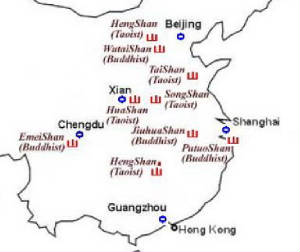
|
====TAOIST
3. Hua Shan, Shaanxi; Taoist Mt.
of West,
19. Zhong Nan Shan, Shaanxi
1. Heng Shan Nan, Hunan; Taoist Mt. of
South
2. Heng Shan Bei, Shanxi; Taoist Mt. of North
4. Tai
Shan, Shandong; Taoist Mt. of East
5. Tong Shan, Henan; Taoist Mt. of Center
====BUDDHIST
8. Jiu
Hua Shan, Anhui; Buddhist Mt. of South.
6. Emei Shan, Sichuan; Buddhist Mt.
of West.
7. Wu Tai Shan, Shanxi, Buddhist Mt. of North.
9. Pu Tuo
Shan, Zhejiang; Buddhist Mt. of East
10. Huang Shan, Anhui;
31. Qi Yun Shan, Anhui (Taoist Mt.)
23. Wu Dang Shan, Hubei;
34. Huang Mei Shan, Hubei
Famous Chinese Peaks: 'Mount Wudang is located near the Shiyan City, northwest of Hubei
Province. It is southeast of Mt. Hua Shan...Local people call it another name: Mount Tai He or Mount XuanYue.'
References
| Map: Origins and regions of abundance |
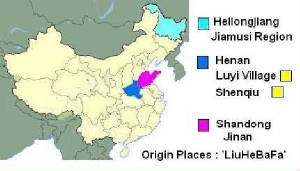
|
| As per available records |
On the Origins of LiuHe BaFa : Jiang
Rong Qiao (1890-1971)
“as a forward for Chen Yi Ren’s
book entitled “Liuhe bafa Chuan”, published September 1st, 1969. Jiang Rong Qiao, founder of Jiang Style Bagua
Zhang, studied Liuhebafa from Wu Yi Hui during his time at the Nanjing Central Martial Arts Academy, where he became
close friends with Chen Yi Ren.
"Liuhe bafa's place of origin
is Lu-yi Village
[ 陸一村 ] , located in [ 河南 ] Henan Province's Shen
Qiu County. [ 省沈丘县 ] [??ShangQui ??] [subjective due to origin of Chen] That
region ..., as well as Hei-long-jiang Province's [ 黑龙江省
] Jia Si Mu Region, [佳木斯市
] are places where it exists in abundance. "However, even among those practitioners,
the Liuhe bafa training method of Wu Yi Hui is distinct; his Liuhebafa as an art and skill have considerable worth."
"Another specialist in Liuhe bafa
is Mr. Xu Wen Bing, 許文冰 a
feudal official of Jinan City 濟南, Shandong 山东 and
former Manager of Henan Province's 河南 Martial Arts Academy. 武術
wǔ3 shu4, 專科院校 zhuān2 kē2 yuàn4 xiào4 Academy.
However, his Liuhe Bafa is not as refined as that of Wu Yi Hui."
[ Notes : Chen Bo Tuan : birth name, Chen Tuan ... start of the Song 宋朝 Dynasty
: 960-1279; , possibly in what is now 陸一村 Lu-yi
in Henan Province 河南 located
in the eastern, central part of the country. The name 河南 Henan means "south 南
of the (Yellow 河 ) River" (Huang He). 省 Province 县 district, county
sheng3 xian4 陸一村 Lu4-yi1 cun1, land-one- village-hamlet; 村 cūn1,
village, hamlet 省沈丘 = 省 sheng3 [xian3] province; 沈 chen2 [shen3,
name]; 丘 qui1, hill 县 xian4, County; [[ Shangqiu 商丘市 Shāng2qiū2
Shì 4 Prefecture-level city ]] ?? Hei-long-jiang Province 黑龙江省
Hēilóngjiāng Shěng Jiamusi 佳木斯市
Jiāmùsī Shì Prefecture-level City.]
| Known variants: 96- and 104-form series |
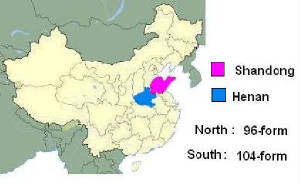
|
| A predecessor or extension |
|
 |
|
| Travel history of Wu Yi-hui within China |
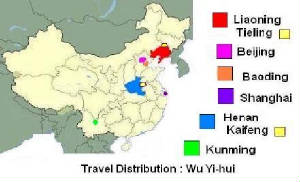
|
History Msr. Wu :
“Wu Yik Fan was originally from Tieling
in Northeast China, but later lived in Beijing.
"He was from a scholar and official family and a man of good
nature who had strong martial art talents. he was also well versed in calligraphy and painting, enjoying social life and travel.
“In 1896, his father took a government
position in Pien liiang and his family moved there; he studied all styles of martial arts and weaponry,
such as “Liu Ho Ba Fa, Three Positions Twelve Stances, and the earliest Taoist Sleeping Chi Kung of Chen Tuan.”
Two years later, he studied under Msr. Chen Kuang Ti and his skills ' greatly improved '.
“In 1905, Wu was admitted to the Military
Academy of Bao-ding. On weekends, he went to the Temple of the Goddess of Mercy Kwan-Yin in the
suburbs where Grand Msr. Chen Huo Lu taught him the secrets of martial arts.
“In 1928, Master Wu started to teach
martial arts at the South Senior High School in Shanghai. The following year he was transferred to Shuwei
Public School.
In 1932, the YMCA in the Eight Immortal Bridge District in Shanghai hired him as their martial arts director.
“In 1936, (at the request of general
Chang Chi Kung) Wu took the provost position at the National Martial Arts Association, Nanjing. When Japan invaded China,
he left first to Kunming and then Guiling, from where he was invited
by the Vietnamese government to demonstrate Chinese martial arts in Hanoi.
“In 1945, the Sino-Japanese war ended,
Master Wu returned to Shanghai and taught martial arts again. He had students from various provinces
in China as well as from Hong Kong, Singapore, South East Asia, Brazil, England and the United States. Meanwhile, the City
of Shanghai made him a member (director) of the Department of Literature and History.
| Overall Distributions Known |
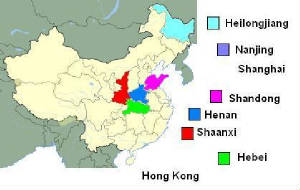
|
| Teachers and Students |
| Lu Hong 8-link Boxing: a LHBF companion |
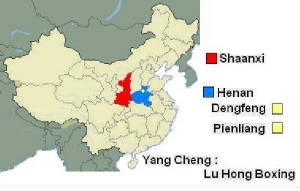
|
| Origins and Distribution |
Lu Hong Ba Shi 呂紅八勢 ,「呂紅拳」 Lu Hong
Chuan.
Master Lu Gui Yao 盧 桂耀 was a
student of Founder Wu Yi hui. 吳翼翬 He learned
the following by Grand Master Wu 吳: Lu
Hong 8 Form:呂紅八勢 LH8 is NOT a [Chen] Xi-yi Men 希夷門 style martial
art. Its' origins before then is ambiguous. Also called Yáng-chéng 陽城 [拳] It started from a teacher Li3 Feng2 -yuan2 李逢源 at @Deng2 Feng2 登封 Province 建,
Henan 河南 :
Li3 Feng2 -yuan2 taught LH8
to four (4)-students :
>> 熊占元
Xiong2 Zhan1-yuan2 @ Huang1-chuan2 潢川 Province
>> 魏履成
Wei4 Lu3-cheng2 @ Huang1-chuan2 潢川 Province
>> 邢昆
Xing2 Kun1 @ Nan-yang 南陽 Province, and...
>> 鄧展熊
Deng4 Zhan3-xiong2 @ He1 bei3 河北 Province in a place 大名
Da4 ming1
Deng 鄧
taught in @ He1 bei3 河北 Province : Qing2 xiang4 青縣
County, to :
>> 宋老邁
Song4 Lao3-mai4, @ Hebei Province, Qing County, in sequel, Song 宋 taught his son
>> 宋清文
Song4 Qing1-wen2, who in sequel again...taught later founder of LiuHe BaFa
>> 吳翼翬 Wu Yi-hui ; who then included LH8 as
part of the LHBF exercise.
Note : Wu Yi Hui was originally
from Tieling 鐵嶺 a prefecture-level city in Liao-ning Province in Northeast China, [a
city where coal mining is an important industry ]; his father took a government position in Pien-Liang (Kaifeng) 開封 formerly
known as Bian-liang (汴梁 or 汴樑 ) a prefecture-level
city in eastern Henan Province.
http://en.wikipedia.org/wiki/Pien-Liang
|
 |
|
|
 |
|
|
 |
|
|
|
Supporting data can be found in authors publication
|
|
|
 |

